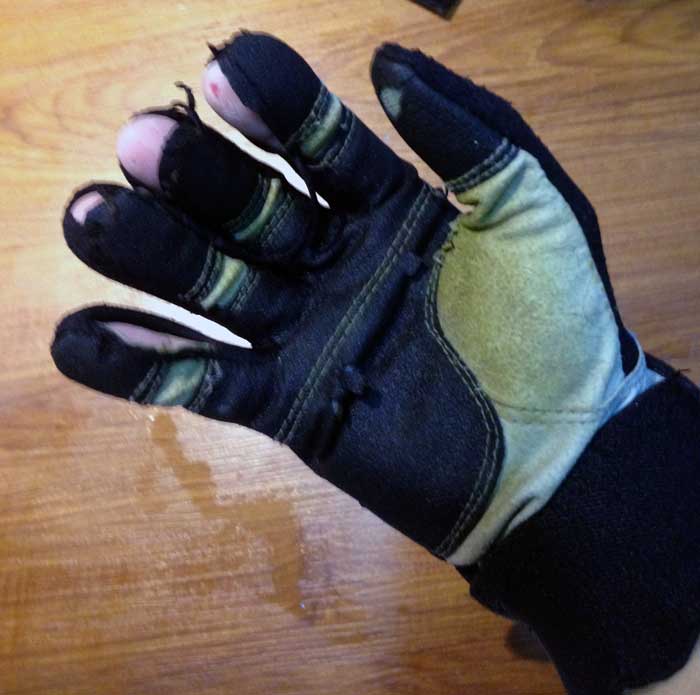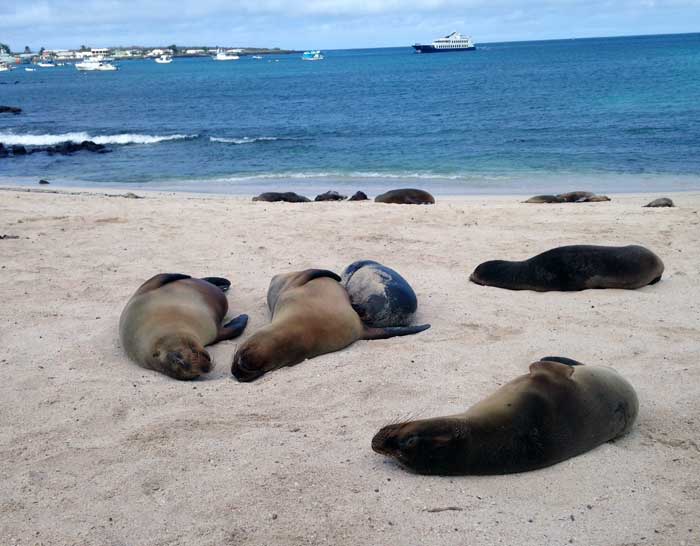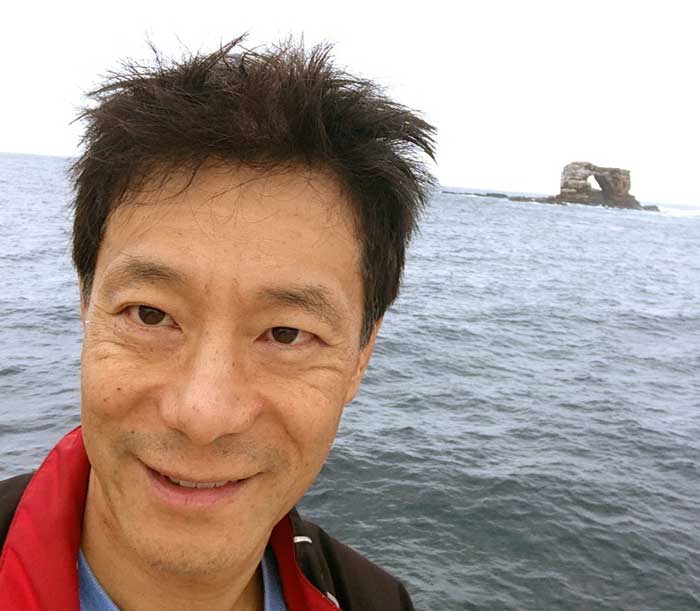
Scuba Diving In Galapagos Islands – General Travel Information
One of my bucket list dive trips has always been the Galapagos Islands. The Galapagos Islands are a nature lover’s dream and people who take the effort to travel there are usually there to see the famous giant tortoises, blue footed boobies, iguanas, seals and other wildlife. To scuba divers, the Galapagos is usually considered as the ultimate mecca dive destination or the holy grail of scuba diving that most divers dream of going to. In September of 2019, I finally made it there as my first scuba diving liveaboard trip – I did a video tour of the Calipso liveaboard dive boat at a separate post which would be very interesting if you have never seen the inside of one before.
There are no direct flights to the Galapagos Islands from outside of Ecuador so you have to fly into Quito, the nation’s capital or Guayaquil which is the port city (even though you likely have to stop over at Quito anyway). It’s an overnight in Guayaquil since in order to get to Galapagos you then need to catch a morning domestic flight into either Baltra or San Cristobal depending on where your particular dive liveaboard is based. There is an additional $100 entry fee required for those traveling to the Galapagos as well as baggage weight limitations on the domestic flights.
So was the Galapagos ever bit of the dive mecca I expected it to be especially for the costly price of paying over $6,000 Canadian for it?
In short, yes but there were some realities that other potential dive travellers should be aware of which I’ll point out here in this article as well as in the video below.
In order to dive the best dive sites in the Galapagos, you need to go the Wolf and Darwin islands which have the most sharks and other big pelagic marine animals. These are very remote island 12 hours away from civilization and much too far for any day boat to get to. So to access Wolf and Darin islands, one must take a liveaboard boat which will be at sea for a week on which you will dive, eat and sleep. This is where the big cost will be.
There are also two main seasons in the Galapagos. If you go during the first half of the year, the water temperatures will be near tropical and you will still see lots of sharks. But if you want to see whale sharks like I did, you must go during the second half of the year which is whale shark season so I went in September.
Colder Water Temperatures In Galapagos
Here’s the first big reality to know. If you go during whale shark season, the water temperatures will be colder. We hit a high of about 24 degrees Celcius which isn’t too bad but thermoclines can take this down to 15 degrees Celcius. We were warned that at some dive sites, the water temperatures could plunge even more. So get ready for colder waters than you are likely use to for diving especially if you have been a tropical water diver only.
I brought a drysuit to this trip since I predicted almost two years before this trip that I would be coming to the Galapagos and I would want to keep as warm as possible. So I was okay with the colder water temperatures but many of my fellow divers who dive mainly just tropical waters, did get cold even with 7 mm wetsuits and hoods. Some divers actually skipped some dives simply because they were too darn cold. Many divers who used 7 mm wetsuits added extra layers for more warmth but of course these required adjustments in amount of weights used.
My drysuit worked fine in terms of keeping me warm but there were a few complications with it. I had to release air from it in addition to the air in my BCD during safety stops to prevent from ascending too quickly. Also, with repeated use of my drysuit all day long over multiple dive days, I ended up with bruising and irritation along my neck and wrists where the drysuit seals are. I’ll have to come up with a solution if I ever do another heavy week of diving with my drysuit again or just limit my colder water diving to maybe just two tank dive days over a maximum of say three days instead of an entire week of full days. This is probably what I would do for a future dive trip to BC, Canada because believe me, these bruises were no fun at all.
Heavy Currents In Galapagos Scuba Diving
Another main reality is that the waters here are rough with big currents all the way from the surface to the bottom. The Calipso gave us Dive Alert whistles and Nautilis Lifelines as standard gear to use during our dive week. When you get to the bottom of many of the dive sites, you had to more or less move from rock to rock much like rock climbing and crawling on the bottom to the view points where the group will be watching for sharks to pass by. At the view points, we had to hang onto rocks the entire time.
So bring dive gloves as the rocks are often encrusted with sharp barnacles and as you can see below, my dive gloves did not survive the week.

It’s a good idea to work out with the divemasters some contingency plans in case divers do get swept away and separated from the rest of the group because of the high currents. This actually happened to me as I was slow in my descent during one dive and by the time I got halfway down, the group was already too far away and the current was taking me in the opposite direction so I had to abort the dive. Fortunately one of the panga inflatable boats was at the surface not too far away from where I came up. This was the one and only time of the trip that I felt real fear in these rough ocean diving conditions.
In hindsight, I wish that we had two divemasters per group of 8 divers from each panga boat so that one will lead and one will be in the back to make sure the entire group stays together. This is the way we did drift dives in Cozumel. But I suppose for Galapagos liveaboards, doubling the manpower of divemasters would not be feasible.
Inflatable Panga Zodiac Boats For Scuba Diving
Another reality of Galapagos scuba diving from the liveaboards is that we had to use the inflatable panga or Zodiac boats to get to the dive sites. There’s no way that the big liveaboard boats could anchor near the dive sites so this is when the panga boats came into use. As you can see from the video below, it was already a challenge to load onto the pangas from the liveaboard because of the waves. But the real big challenge was climbing back into the panga boats after each dive since we had to remove our weight belts, BCDs and fins before climbing in and all in rough seas. I actually let my weight belt slip at the end of one dive but fortunately another diver was able to retrieve it. Other divers got swept underneath the pangas by the waves.
I really did not like using the pangas. Unlike the nice dive boats you can do easy giant strides from in the tropical regions, the pangas were the only feasible type of boat to dive off with the Galapagos liveaboards. I saw the Aggressor liveaboard a few times at the same dive sites as the Calipso and they were using the same identical panga boats that we did.
Nitrox For Galapagos Scuba Diving Liveaboards
The dive program offered by Galapagos liveaboards is an intensive one with three to four dives daily for a week. Most of the dives are considered deep at about 72 to 78 feet for maximum depth. So Nitrox would be useful. In fact, I believe that all 16 guest divers and all divemasters on our liveaboard used Nitrox all week.
Most of my fellow scuba divers on this Galapagos trip had much more dive experience compared to me and some are liveaboard veterans. But there was a general consensus that with the combination of colder water temperatures and heavy currents at the dive sites, these were the most challenging dive conditions they have ever experienced. So I did not feel that bad whenever I had trouble during my dives.
Magic Of Galapagos Scuba Diving
Now with all the important harsh realities out of the way, there are the huge rewarding upsides in Galapagos scuba diving which made my trip every bit the bucket list trip is was. I was hoping to see one whale shark but I ended up seeing five. Most scuba divers come to the Galapagos Islands especially to see sharks, lots of them. During the second half of each year, the big seasonal stars are of course the whale sharks but the co-stars would have to be the hammerhead sharks who are there all year round.
Most scuba divers visiting the Caribbean destinations would be lucky to see one or two sharks during an entire trip unless it was a special shark dive or on a dive liveaboard to more remote areas that the land based day boats cannot reach. One just doesn’t see many sharks during typical reef dives in the Caribbean, never mind hammerheads. I’ve never see hammerheads in real life before this trip and while diving at Wolf and Darwin Islands watching the ‘shark highway’, I didn’t even bother to count them as there were so many! Here’s video footage of sharks galore during the Galapagos dives.
One of the most unique dives I ever had were watching the marine iguanas off Fernandina Island as these are the only known iguanas in the world that actually feed underwater. As you’ll see in this following video, I was able to get up pretty close to them as they just didn’t seem to care whether there were any divers looking at them or not unless there were too many of us at one time. It was even funny to watch them on the surface too with just their little heads sticking out of the water while swimming.
I saw my first baitball of fish on this trip too (when large numbers of fish group up like a giant ball). As a huge bonus, I saw my first mola mola. You will catch a short glimpse of one in the video as it looks like some alien fish with huge fins on the top and bottom. Most scuba divers will never get to see a mola mola and most have never even heard of one, myself included until just last year.
On top of all these sightings, I had some interesting, entertaining and magical encounters. Even the little fish here in the Galapagos are not afraid of divers as they get really close. I actually had two small fish nibble on my fingers when I was hanging onto the rocks watching the sharks (the joke is that they wanted to try out Chinese food).
We even captured on video an incident when a sea turtle slapped me in the head with its flipper! It was hovering near my head behind me and when one of the dive masters motioned for me to turn around to see it, the sea turtle must have gotten too close to me and one of its flippers slapped me in the head. I actually didn’t realize it until the other divers told me afterwards on the panga boat.
Another magical encounter I will never forget is when I was looking at my dive computer (which is lit up) during the safety stop of one dive and suddenly a seal came. This seal poked its face in to try and see my dive computer. I must have given it a look as if I was asking it what the heck it was looking at. Too bad we did not get this on video but we did get some really good moments as shown below so you’ll get an idea what I got for a $6,000 dive trip!
The only wildlife that our tour was not able to see and dive with were with penguins. The island that had the penguin colony was closed down the week we were there so to make up for what would have been another very interesting dive, we were given a night dive in a cave instead which was quite interesting too. I didn’t get any video footage of this cave dive but there were surprisingly quite a few marine life inside including rays, sea turtles and fish.
So overall, I was quite satisfied with my Galapagos scuba diving adventure. Just be aware if you go on this type of trip, it is not an easy, relaxing type of dive trip in the Caribbean. In fact this trip was the most intense week I’ve ever had, even more intense compared to some of my rocky mountain ski trips. At the end of each dive day, I was out of gas both physically and mentally. I’m sure that I was not the only one as most of us already retired into our cabins for sleep by 9 pm each night.

At the end of the intensive scuba diving week out in open sea with the Calipso liveaboard and still bruised up from my drysuit seals on my neck and wrists, I was actually quite happy to be back on land to see the famous giant tortoises as one cannot really leave the Galapagos Islands without seeing them.

After the giant tortoise tour, I spent a few hours just walking around town where I came across some beaches with lots of seals just lying around in the sun. I was able to walk up pretty close to them to shoot some video shown here below.
Galapagos Scuba Diving Liveaboard Trip Of A Lifetime
This trip was truly an adventure of a lifetime. For me, it’s a bucket list dive trip finally done after a few years of planning. Although there were one or two divers on my trip who were on their second time around for a Galapagos dive liveaboard, I think that would be it for me as once is enough.
It’s not really the high cost of such a trip since I do plan to go on more dive liveaboards in the future particularly to Raja Ampat in Indonesia. But even with all the incredible moments I had in the water while diving in the Galapagos which I’ll never forget, I think spending an entire week in such rough sea conditions and getting all bruised up by my drysuit seals like the way I did was too much to get me to do a repeat trip. I now understand why most scuba divers will never make it down to the Galapagos as this was pretty extreme diving. It is a very intensive trip and certainly a huge contrast to a typical relaxing Caribbean trip that most scuba divers will go on.
The Galapagos Islands is actually part of what’s known as Hammerhead Triangle with Cocos Island and Malpelo Island as the other two destinations. All three locations are remote islands in the same Pacific Ocean region with huge hammerhead (and other) sharks activity plus all three require liveaboard boats to get to them. We can throw in Socorro Islands further north off Mexico too as another similar liveaboard trip to see a lot of pelagic marine life action. I would be interested in going on these other locations too in the future although they will all be intensive trips some requiring 30+ hours of boat travel to get to.
The entire week on board the Galapagos liveaboard was pretty well dive, eat, sleep and recover repeated several times per day all week long. The Galapagos Islands (nor the other destinations of Hammerhead Triangle) are certainly not for every scuba diver. But for those divers who are committed to go to this ultimate dive destination, then by all means go for it. Just prepare yourself for this adventure of a lifetime.

